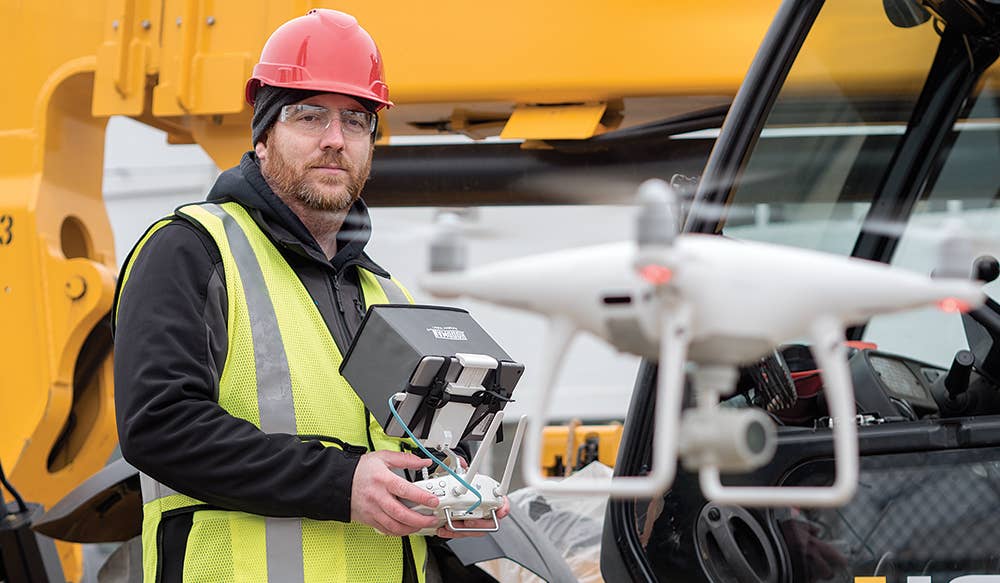
Drone rules in plain English. Daniel Herbert/Skygear Solutions
Relevant Discussion: FAR part 107, AC 107-2
Operating Requirements:
Avoid manned aircraft, and never operate in a careless or reckless manner.
The drone must remain within sight. Alternatively, if you use first-person view or similar technology, you must have a visual observer always keep your aircraft within unaided sight (for example, no binoculars are allowed).
Neither you nor a visual observer can be responsible for more than one unmanned aircraft operation at a time.
You can fly only during daylight or civil twilight (30 minutes before official sunrise to 30 minutes after official sunset, local time). Operations during civil twilight require appropriate anti-collision lighting.
Minimum weather visibility is 3 miles from the control station, 500 feet below clouds and 2,000 feet horizontally from clouds.
Maximum altitude is 400 feet agl, or if within a 400-foot radius of a structure, 400 feet above that structure's immediate uppermost limit.
Maximum speed 87 knots (100 mph).
You cannot fly a small UAS over anyone who is not directly participating in the operation unless the nonparticipating persons are located under a covered structure or stationary vehicle that can provide reasonable protection from a falling UAS.
Cannot be operated from a moving aircraft. Cannot be operated from a moving land or waterborne vehicle unless it is over a sparsely populated area.
Operations in Class G airspace are allowed without air traffic control permission. Operations in class B, C, D and E airspace need ATC approval.
You can carry an external load if it is securely attached and does not adversely affect the flight characteristics or controllability of the aircraft. You also may transport property for compensation or hire within state boundaries.
You can request a waiver of most operational restrictions if you can show that your proposed operation can be conducted safely under the waiver.
Pilot Certification:
To operate the controls of a small UAS under Part 107, you need a remote pilot airman certificate with a small UAS rating, or to be under the direct supervision of a person who holds such a certificate.
You must be at least 16 years old to qualify for a remote pilot certificate, and you can obtain it in one of two ways:
You may pass an initial aeronautical knowledge test at an FAA-approved knowledge testing center.
If you already have a Part 61 pilot certificate, other than a student pilot certificate, you must have completed a flight review in the previous 24 calendar months and you must take the small UAS online training course.
Within the previous 24 months, a remote pilot must have passed an initial or recurrent aeronautical knowledge test. A Part 61 pilot certificate holder who has completed a flight review within the previous 24 months may complete a recurrent online training course instead of taking the recurrent knowledge test.
- If you have a nonstudent pilot Part 61 certificate, you will immediately receive a temporary remote pilot certificate when you apply for a permanent certificate. Other applicants will obtain a temporary remote pilot certificate upon successful completion of a TSA security background check.
Model Aircraft, aka UAS, and Your Pilot Certificate: (FAA Order 2150.3B Compliance and Enforcement Bulletin 2014-2, AC 91-57A)
The FAA claims ownership of all airspace from the ground up and all "aircraft" that fly in it. The FAA's definition of "aircraft" includes virtually anything that flies in its airspace, including drones.
"If the operation of a model aircraft endangers the safety of the national airspace, the FAA may cite violations of applicable operational regulations in any enforcement action determined to be appropriate."
"A certificate holder [pilot] should appreciate the potential for endangerment that operating a UAS contrary to the FAA's safety regulations may cause [better than a nonpilot]. Accordingly, a violator's status as a certificate holder is an aggravating factor that may warrant a civil penalty above the moderate range for [even] a single, first-time, inadvertent violation."
If the model aircraft endangers safety, the FAA may site violations of FAR 91.13, 91.15, 91.113, 91.126-135, 91.137-145 and/or Part 73.
In other words, if you're a pilot, you stand a much better chance of receiving a violation if you do something that, in the opinion of an FAA inspector, is a "potential risk to safety."
Which means, if you're a pilot, you could have your certificate suspended or revoked or even face fines if some persnickety FAA inspector doesn't like when, where or how you fly your toy airplane. Holy moly!
If you own a drone or other recreational model aircraft that weights more than 0.55 pounds (8.8 ounces), it must be registered with the FAA’s UAS registry. The unique ID number you receive must be marked on all model aircraft you own. Registration is valid for three years.
FAA statute defines an aircraft as “any contrivance invented, used or designed to navigate or fly in the air.”
FAA regulations could change at any time. Please refer to current FARs to ensure you are legal.

Subscribe to Our Newsletter
Get the latest FLYING stories delivered directly to your inbox






